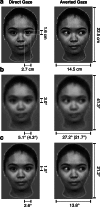Eye contact detection in humans from birth
- PMID: 12082186
- PMCID: PMC123187
- DOI: 10.1073/pnas.152159999
Eye contact detection in humans from birth
Abstract
Making eye contact is the most powerful mode of establishing a communicative link between humans. During their first year of life, infants learn rapidly that the looking behaviors of others conveys significant information. Two experiments were carried out to demonstrate special sensitivity to direct eye contact from birth. The first experiment tested the ability of 2- to 5-day-old newborns to discriminate between direct and averted gaze. In the second experiment, we measured 4-month-old infants' brain electric activity to assess neural processing of faces when accompanied by direct (as opposed to averted) eye gaze. The results show that, from birth, human infants prefer to look at faces that engage them in mutual gaze and that, from an early age, healthy babies show enhanced neural processing of direct gaze. The exceptionally early sensitivity to mutual gaze demonstrated in these studies is arguably the major foundation for the later development of social skills.
Figures



References
-
- Driver J, Davis G, Ricciardelli P, Kidd P, Maxwell E, Baron-Cohen S. Vis Cogn. 1999;6:509–540.
-
- Butterworth G, Jarrett N. Br J Dev Psychol. 1991;9:55–72.
-
- Kleinke C L. Psychol Bull. 1986;100:78–100. - PubMed
-
- Hains S M J, Muir D W. Child Dev. 1996;67:1940–1951. - PubMed
-
- Symons L A, Hains S M J, Muir D W. Inf Behav Dev. 1998;21:531–536.
Publication types
MeSH terms
LinkOut - more resources
Full Text Sources
Medical

